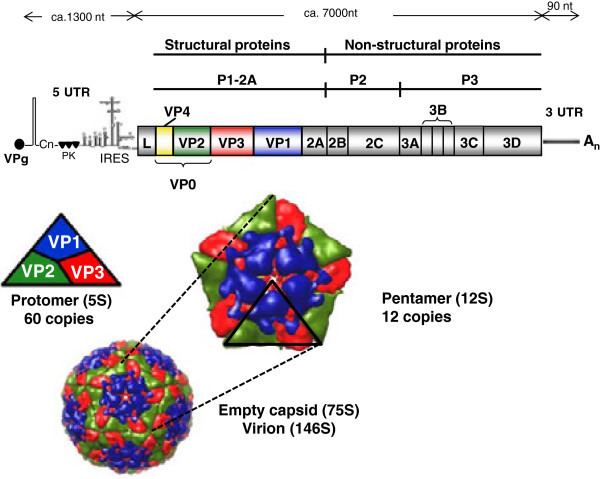Group Group IV ((+)ssRNA) Family Picornaviridae | Rank Species | |
 | ||
Similar Picornavirus, Cardiovirus A, Positive‑sense single‑stranded RNA virus, Coxsackievirus, Porcine reproductive and respi | ||
Lifecycle of foot and mouth disease virus
The foot-and-mouth disease virus (FMDV) is the pathogen that causes foot-and-mouth disease. It is a picornavirus, the prototypical member of the Aphthovirus genus. The disease, which causes vesicles (blisters) in the mouth and feet of bovids, suids, ovids, caprids and other cloven-hoofed animals is highly infectious and a major plague of animal farming.
Contents
- Lifecycle of foot and mouth disease virus
- Diamond light source harwell foot and mouth disease virus life cycle
- References
The virus particle (25-30 nm) has an icosahedral capsid made of protein, without envelope, containing a single strand of ribonucleic acid (RNA) containing a positive encoding of its genome. When the virus comes in contact with the membrane of a host cell, it binds to a receptor site and triggers a folding-in of the membrane. Once the virus is inside the host cell, the capsid dissolves, and the RNA gets replicated, and translated into viral proteins by the cell's ribosomes using a cap-independent mechanism driven by the internal ribosome entry site element.
The synthesis of viral proteins include 2A 'cleavage' during translation. They include proteases that inhibit the synthesis of normal cell proteins, and other proteins that interact with different components of the host cell. The infected cell ends up producing large quantities of viral RNA and capsid proteins, which are assembled to form new viruses. After assembly, the host cell lyses (bursts) and releases the new viruses.
The foot-and-mouth disease virus occurs in seven major serotypes: O, A, C, SAT-1, SAT-2, SAT-3, and Asia-1. These serotypes show some regionality, and the O serotype is most common.
